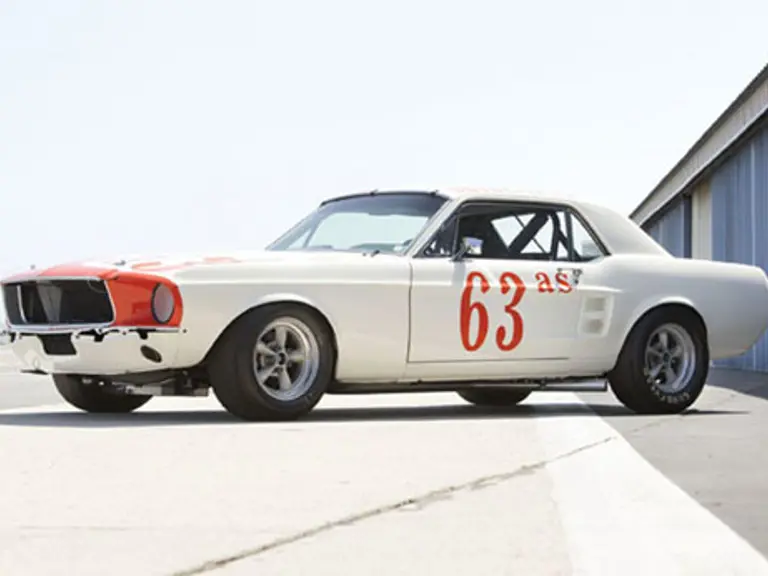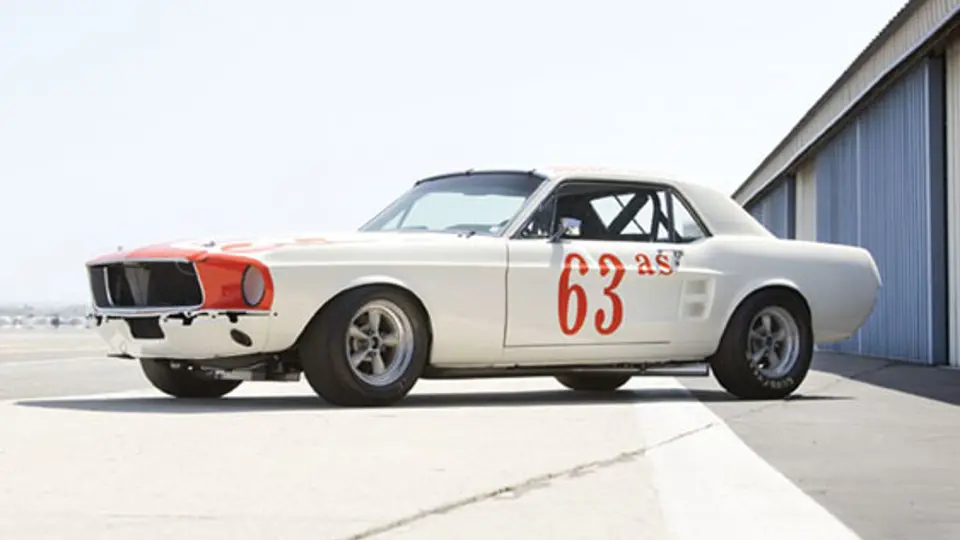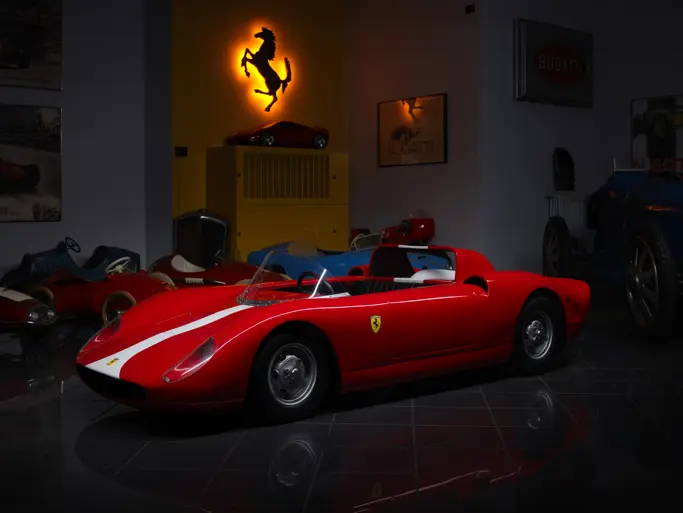The Trans-Am series, officially called the Trans-American Sedan Championship, in 1966 consisted of seven professionally recognized races at road courses throughout the United States. The accumulation of points, based on finishing position would determine the season manufacturer’s champion.
The 1967 Mustang notchback Group II sedan was Shelby American's competition model for 1967. The same rule that allowed the 1965 GT 350 to compete in the SCCA B Production class - no rear seats - effectively kept the Shelby Mustangs out of the Trans-Am series. It didn't matter that by 1967 you couldn't buy a Shelby Mustang without a back seat. The rules that had been set in 1965 continued to be observed.
This situation was very plausible for Ford, who liked the idea of Carroll Shelby racing their popular car that was easily identifiable to the public as a Mustang. Ford had left the Trans-Am to the independents in 1966 and nearly fell short. Shelby and driver Jerry Titus in his Shelby-prepared car would save Ford’s manufacturer’s championship by scoring enough points with winning the final race of the season at Riverside.
Their enthusiasm continued, and Ford was keen to take part in the 1967 Trans-Am series and sell many additional cars with such positive publicity. The SCCA quickly realized they were on to something and they expanded the Trans-Am to twelve races. They saw manufacturer support as the key to the series' success and did everything they could to entice marques like Ford, Chevrolet and Mercury. The manufacturers, in turn, saw the Trans-Am as the perfect vehicle to market their new “Pony” cars.
The very first thing Shelby American had to do was homologate the 1967 Mustang. A review of the FIA's Group II rules for sedans showed that most of the mechanical modifications Shelby had come up with for the GT 350 R would be allowed on the Group II car. In addition, since the R-Models had been raced for two years, their components and modifications had been thoroughly evaluated and refined. By the time Shelby American began converting 1967 Mustang notchbacks into racecars, they knew what would work best for the car.
Group II rules specified that cars had to maintain their basic stock appearance, including all window glass. The job of coming up with specifications for the 1967 Group II cars landed on the desk of Shelby American GT 350 Project Engineer Chuck Cantwell. His experience with the GT 350 competition model and 1966 Group II cars made him the obvious choice. Fabricator Jerry Schwarz, who also had participated in the prior projects, did most of the hands-on work. They built a prototype and from it came the team and customer cars.
The 1967 Trans-Am series was a breakout year in that the automotive and racing press held the series in high regard and recognized the professional level of its participants. More importantly, so did the manufacturer’s, who continued to support the racers. Meanwhile the fan base continued to grow at a rapid pace. Even more attention was garnered when the final race of the season was once more a “winner-take-all” shootout that would again see the Shelby Mustang at the top when the final points were tallied.
Factory documents show that Shelby American built a total of 26 1967 Mustang Group II racers. One was a prototype which was never actually raced by the team. It was used for evaluation of components and then sold during the race season. Four were actual team cars and the remaining 21 cars were sold to independent racers who used them in Trans-Am and/or SCCA A/Sedan competition.
The Group II Shelby Mustang that is being offered is Car #24 of the reported 26 prepared by Carroll Shelby for the SCCA Trans-Am Series and was originally sold to and raced by Fred Sutherland. After many years apart, the Shelby and Mr. Sutherland reunited and the car has been restored as closely to the original specifications that memories, documentation and vintage photos allowed, and to be able to run current historic racing events.
Like the GT 350 Shelby built for the SCCA B/Production class, this version has all the Shelby details. In 67 the Shelby team used four team cars to win the championship. The balance of the cars was sold to customers for racing. These cars came heavily equipped. Among the many features are a race-prepped Hi-Po 289-cid engine mated to a Top-Loader four-speed transmission, relocated upper A-arm mounts, bigger disc brakes on the front, driveshaft retainer strap to keep it from falling if a U-joint should fail, nine-inch rear axle housing with the customer's choice of gear ratios, racing oversize wheel studs and nuts, an SCCA-approved rollbar, "Over-Rider" traction bars from the top of the axle into the interior, stripped interior with a single fiberglass racing bucket seat and competition harness, special racing gas tank with dual electric fuel pumps with the battery in the trunk, rear firewall, no heater or fan, American Racing magnesium Torque Thrust D Wheels, Goodyear racing tires, racing headers and straight dump pipes ending in front of the rear tires, front license plate recess cut out for an oil cooler, window retainer straps, hood pins, brake cooling ducts, racing springs, Koni double-adjustable racing shocks, fire extinguisher, aluminum plates where the headlights go, racing wire harness, tachometer and oil pressure gauges set in an aluminum dash insert, no speedometer, aluminum switch box on the center tunnel behind the shifter and more. The cars left Shelby's Culver City, California factory truly ready to race except for numbers and fuel. The engine was rebuilt by Dave Dralle, who successfully raced Cobras in the 1960s and is considered to still be one of the best in relation to Cobra and Mustang expertise. The engine is reported to have tested at 487 horsepower on the dynamometer, which is about 17-hp more than the Bud Moore-prepared Mustang Boss 302s achieved in their championship year of 1970. This machine has benefitted from a full rotisserie rebuild.
As mentioned earlier, the car is owned again by its original owner, Fred Sutherland. He relates that he had bought it new from Shelby for approximately $4,000 and due to its delivery being tardy; he was offered a free paint job of his choice by Mr. Shelby. He conveys that he won some races and set some lap records with it. It is related that a race program from an SCCA race at Willow Springs in 1969 lists the lap records for the track. For the A/Sedan Class, which is the over two-liter class for Trans-Am cars, Fred held the lap record with this car at that time. Very impressive considering the Shelby team and many others used this track for practice. Just before ordering this car, Mr. Sutherland had won the regional Championship for A/Production with his 289 Cobra.
Among the other track achievements for this well-documented car and Fred Sutherland are winning overall first time out at the 1967 Times Riverside Grand Prix for production sports cars. Following this success was second overall for A/Sedan at the 1967 Daytona American Road Race of Champions and first in A/Sedan at the 1968 Stardust International Raceway in Las Vegas. From here the car had numerous owners, as racecars are well-known for. Prior research by the SAAC shows that the Shelby was purchased by Jim Whelan of Minnesota and raced in the 1969 Brainerd Trans-Am race. Sam Miller purchased the car in late 1969 and it was raced in Midwest regional and national events. Norman Frame acquired the Shelby in early 1974 and the car was the 1976 Southeast Division regional champion and raced at Road Atlanta, Charlotte Motor Speedway and in the Camel GT series. In 1979 the car was purchased by Gordon Stennes in 1979, before changing hands three additional times without mention of the car being raced with this succession of owners. Mr. Sutherland reacquired the Shelby in 2009 and put into the capable hands of John Ryals for the restoration. Mr. Ryals worked for the aforementioned Jerry Schwarz (original Shelby American crew member/fabricator) when they were both on the Roy Woods Racing Team when they campaigned the ex-Penske Javelins in 1972.
This fine representation of Shelby Mustang Group II Notchback racecar won last year’s Shelby American Automobile Club meet. Also included in the sale are the correct and original dual carbs and manifold setup (the car races much better with the current setup), documentation tracking the ownership history, a Deluxe Marti Report, original data plate, historical photos and restoration records that total over $400,000 invested in bringing this magnificent racecar back to its former brilliance.



 | Santa Monica, California
| Santa Monica, California


